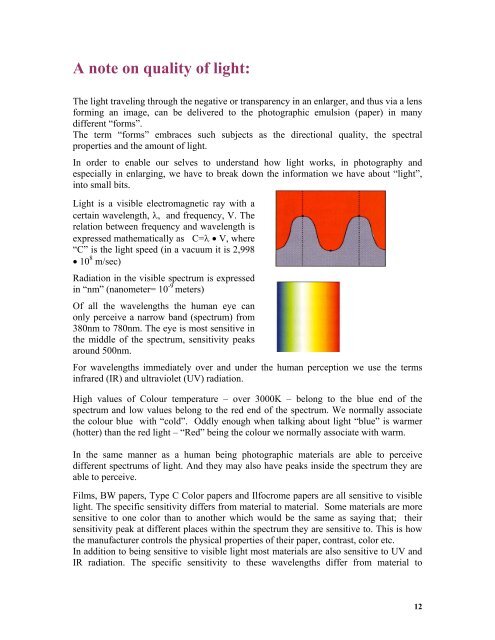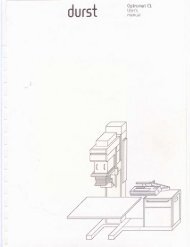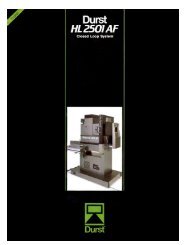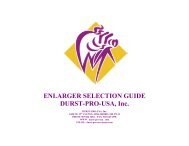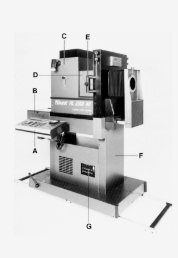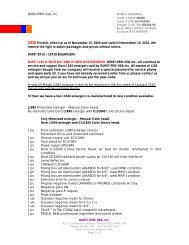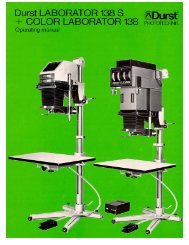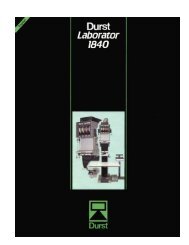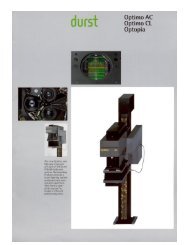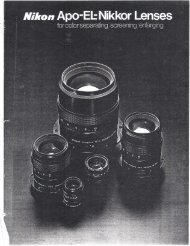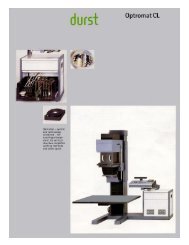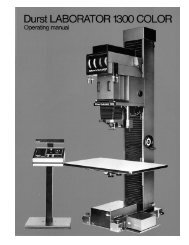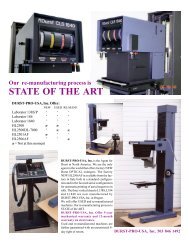A note on quality of light - durst-pro-usa
A note on quality of light - durst-pro-usa
A note on quality of light - durst-pro-usa
You also want an ePaper? Increase the reach of your titles
YUMPU automatically turns print PDFs into web optimized ePapers that Google loves.
A <str<strong>on</strong>g>note</str<strong>on</strong>g> <strong>on</strong> <strong>quality</strong> <strong>of</strong> <strong>light</strong>:<br />
The <strong>light</strong> traveling through the negative or transparency in an enlarger, and thus via a lens<br />
forming an image, can be delivered to the photographic emulsi<strong>on</strong> (paper) in many<br />
different “forms”.<br />
The term “forms” embraces such subjects as the directi<strong>on</strong>al <strong>quality</strong>, the spectral<br />
<strong>pro</strong>perties and the amount <strong>of</strong> <strong>light</strong>.<br />
In order to enable our selves to understand how <strong>light</strong> works, in photography and<br />
especially in enlarging, we have to break down the informati<strong>on</strong> we have about “<strong>light</strong>”,<br />
into small bits.<br />
Light is a visible electromagnetic ray with a<br />
certain wavelength, λ, and frequency, V. The<br />
relati<strong>on</strong> between frequency and wavelength is<br />
expressed mathematically as C=λ • V, where<br />
“C” is the <strong>light</strong> speed (in a vacuum it is 2,998<br />
• 10 8 m/sec)<br />
Radiati<strong>on</strong> in the visible spectrum is expressed<br />
in “nm” (nanometer= 10 -9 meters)<br />
Of all the wavelengths the human eye can<br />
<strong>on</strong>ly perceive a narrow band (spectrum) from<br />
380nm to 780nm. The eye is most sensitive in<br />
the middle <strong>of</strong> the spectrum, sensitivity peaks<br />
around 500nm.<br />
For wavelengths immediately over and under the human percepti<strong>on</strong> we use the terms<br />
infrared (IR) and ultraviolet (UV) radiati<strong>on</strong>.<br />
High values <strong>of</strong> Colour temperature – over 3000K – bel<strong>on</strong>g to the blue end <strong>of</strong> the<br />
spectrum and low values bel<strong>on</strong>g to the red end <strong>of</strong> the spectrum. We normally associate<br />
the colour blue with “cold”. Oddly enough when talking about <strong>light</strong> “blue” is warmer<br />
(hotter) than the red <strong>light</strong> – “Red” being the colour we normally associate with warm.<br />
In the same manner as a human being photographic materials are able to perceive<br />
different spectrums <strong>of</strong> <strong>light</strong>. And they may also have peaks inside the spectrum they are<br />
able to perceive.<br />
Films, BW papers, Type C Color papers and Ilfocrome papers are all sensitive to visible<br />
<strong>light</strong>. The specific sensitivity differs from material to material. Some materials are more<br />
sensitive to <strong>on</strong>e color than to another which would be the same as saying that; their<br />
sensitivity peak at different places within the spectrum they are sensitive to. This is how<br />
the manufacturer c<strong>on</strong>trols the physical <strong>pro</strong>perties <strong>of</strong> their paper, c<strong>on</strong>trast, color etc.<br />
In additi<strong>on</strong> to being sensitive to visible <strong>light</strong> most materials are also sensitive to UV and<br />
IR radiati<strong>on</strong>. The specific sensitivity to these wavelengths differ from material to<br />
12
material. Because the are sensitive to the same spectrum as the human eye they must be<br />
handled in total darkness, or under safe<strong>light</strong> designed for the material in questi<strong>on</strong>.<br />
Most color papers are fairly sensitive to UV and manufactures <strong>of</strong> advanced Color heads<br />
use heat filters that restrict both UV and IR <strong>light</strong> waves in reaching the paper during<br />
exposure. IR radiati<strong>on</strong> is also known as “heat rays”.<br />
The sensitivity curve <strong>on</strong> the right is an<br />
example <strong>of</strong> Kodak <strong>of</strong> Type C paper<br />
sensitivity. From this example it is obvious<br />
that this particular paper is sensitive in the<br />
visible spectrum, it is sensitive from 390nm to<br />
750nm. It is also clear that it is not equally<br />
sensitive throughout the spectrum, it is more<br />
sensitive to blue <strong>light</strong> than to red <strong>light</strong>.<br />
The sensitivity curves below are for Ilford<br />
MULTI GRADE fiber-base paper and for<br />
ILFOCHROME (CIBACHROME) paper .<br />
IMAGINE the spectral sensitivity curves for a<br />
photographic paper super imposed <strong>on</strong> top <strong>of</strong><br />
<strong>on</strong>e <strong>of</strong> the spectral emissi<strong>on</strong> curves for lamps,<br />
shown below, and you will start to understand<br />
why certain lamp types does not work with<br />
certain papers (photographic emulsi<strong>on</strong>s) and<br />
also why certain types <strong>of</strong> safe<strong>light</strong> does not<br />
harm certain papers.<br />
Our eyes and photographic emulsi<strong>on</strong>s are<br />
sensitive to different spectrums <strong>of</strong> <strong>light</strong>.<br />
Lamps <strong>of</strong> different kinds emit energy (<strong>light</strong>)<br />
with different spectrums. Some lamps have<br />
peaks in their spectrum.<br />
Day<strong>light</strong> and incandescent lamps and<br />
tungsten-halogen lamps emit a c<strong>on</strong>tinuous<br />
spectrum – the spectral efficiency curve is<br />
unbroken = without peaks. Both incandescent<br />
lamps and tungsten-halogen lamps <strong>pro</strong>duce<br />
the major part <strong>of</strong> their radiati<strong>on</strong> (emissi<strong>on</strong>) in<br />
the “red” (IR) end <strong>of</strong> the spectrum. As a<br />
matter <strong>of</strong> fact <strong>on</strong>ly 8-9% <strong>of</strong> the total energy<br />
used by a tungsten-halogen lamp is<br />
transformed into visible <strong>light</strong>. More than 80%<br />
is turned into heat (IR) and the rest is either<br />
lost in the <strong>pro</strong>cess or emitted as UV. UV<br />
emissi<strong>on</strong> from an incandescent or tungstenhalogen<br />
lamp is normally below 2%.<br />
Spectral sensitivity curve for<br />
Ilford VC Fiberbase paper<br />
Spectral sensitivity curve for<br />
Ilford ILFOCROME<br />
13
This explains in particular the necessity for<br />
heat filters but also for UV filters in enlarger<br />
heads.<br />
Tungsten-Halogen spectral emissi<strong>on</strong> curve.<br />
Fluorescent lamps and metal-halogen lamps<br />
have broken sensitivity curves – that is; they<br />
emit some <strong>light</strong> in the entire visible spectrum<br />
but the major <strong>of</strong> their emissi<strong>on</strong> are in narrow<br />
bands. See examples <strong>on</strong> your right.<br />
By examining the emissi<strong>on</strong> curves for<br />
fluorescent lamps and the spectral sensitivity<br />
curve for the Ilford Fiber base paper- above –<br />
you will find an explanati<strong>on</strong> as to why some<br />
printers have run into <strong>pro</strong>blems with their<br />
“cold-<strong>light</strong> heads” when using BW-VC paper.<br />
Maybe you have tried to photograph <strong>on</strong> color<br />
film under fluorescent “day<strong>light</strong>” type lamps<br />
and have been surprised to find your<br />
transparencies with a str<strong>on</strong>g cyan/green color<br />
cast. This is caused by the fluorescent lamps<br />
having a spectral emissi<strong>on</strong> different from what<br />
is understood by the film as “day<strong>light</strong>”. Which<br />
essentially is the exact same <strong>pro</strong>blem printers<br />
run into with certain types <strong>of</strong> “cold<strong>light</strong><br />
heads”.<br />
The spectral sensitivity for ILFORD Fiber<br />
Base paper is very high even below the visible<br />
spectrum (380nm) and maintain that<br />
sensitivity up to 525nm where it drops <strong>of</strong><br />
drastically and basically it is not sensitive at<br />
all above 550nm. If the ne<strong>on</strong> tube in a given<br />
cold<strong>light</strong> head had the same spectral<br />
sensitivity curve as our tube “B” it would be<br />
almost impossible to get an exposure <strong>on</strong> the<br />
paper because tube “B” peaks above right at<br />
and above 550nm. And has very little<br />
emissi<strong>on</strong>, apart from UV, in the spectrum<br />
where the paper is sensitive.<br />
As a matter <strong>of</strong> fact all three tubes would be<br />
poor for Ilfords paper which is obviously<br />
designed for Tungsten or Tungsten-Halogen<br />
<strong>light</strong>.<br />
Of the three fluorescent lamps “B” would be<br />
the tube best suited for platinum printing and<br />
A.<br />
B<br />
C.<br />
METAL HALOGEN LAMPS use Ne (Ne<strong>on</strong>) inert<br />
gas which is the same gas as used in ne<strong>on</strong> tubes.<br />
3000K 4500K 5500K<br />
SPECTRAL EMISSION CURVES FOR<br />
FLUORESCENT TUBES / NEON TUBES.<br />
Although all three will look the same to the eye they<br />
certainly differ in emissi<strong>on</strong>.<br />
3200K 4000K 2700K<br />
14
other UV printing due to the very high<br />
emissi<strong>on</strong> in the UV area.<br />
As you will see from the spectral emissi<strong>on</strong><br />
curve for a Phillips safe<strong>light</strong> lamp it’s<br />
emissi<strong>on</strong> has been modified to cover an area<br />
above 600nm. An the emissi<strong>on</strong> in the 600nm<br />
area is at its lowest with most emissi<strong>on</strong> in the<br />
area around 700nm where (Ilford)<br />
photographic paper is least sensitive and the<br />
human eye still able to perceive the emissi<strong>on</strong>.<br />
The color <strong>of</strong> <strong>light</strong> is expressed as “The color<br />
temperature” and it is measured in Kelvin (K).<br />
Degree Kelvin is an absolute temperature<br />
scale c<strong>on</strong>trary to Degree Celsius. T K = T C +<br />
273.<br />
Emissi<strong>on</strong> curve for Phillips darkroom lamp<br />
PF710 and PF712.<br />
Chromaticity<br />
diagram to<br />
DIN5033<br />
The colour <strong>of</strong> <strong>light</strong> = colour temperature can<br />
be described very precisely with a set <strong>of</strong><br />
coordinates (X,Y), in a diagram called a<br />
“Chromaticity diagram”. This diagram is<br />
internati<strong>on</strong>ally recognized and is becoming<br />
more popular in photography and re<strong>pro</strong>photography,<br />
scanning etc. as a universal<br />
standard.<br />
It is important to understand that two <strong>light</strong> sources can have the same colour temperature<br />
but at the same time completely different spectral effect distributi<strong>on</strong>. This is obvious<br />
when comparing the spectral emissi<strong>on</strong> curves for Fluorescent lamp, with a colour<br />
temperature <strong>of</strong> 3200K, to a Halogen lamp with the same colour temperature.<br />
Like sound waves, <strong>light</strong> waves can be manipulated, modified and transformed into forms<br />
needed for a given purpose, in this case printing with an enlarger.<br />
We can mix <strong>light</strong>. The <strong>light</strong> beam from two <strong>light</strong> sources – two bulbs - each with<br />
different spectral emissi<strong>on</strong> characteristics can be mixed to form a third “<strong>light</strong> source”<br />
with a spectral emissi<strong>on</strong> curve different from the two “source” lamps.<br />
We can also modify a <strong>light</strong> source by filtering. IMAGINE a sheet <strong>of</strong> green fabric as a<br />
crude filter. If this “filter” is inserted into a beam <strong>of</strong> <strong>light</strong>, the <strong>light</strong> <strong>on</strong> the “beam side” <strong>of</strong><br />
the fabric will have different characteristics (colour) than the <strong>light</strong> that penetrated the<br />
fabric/filter.<br />
One thing we cannot do – we cannot ad to a <strong>light</strong> source where nothing exists to be<br />
added. We cannot ad a dye, if we want to obtain <strong>light</strong> in a colour different from that <strong>of</strong> a<br />
given <strong>light</strong> source. No such dye exists for practical use. (Light experts will argue that the<br />
15
<strong>light</strong> emitted from ne<strong>on</strong> tubes are dependent <strong>on</strong> powder (dye) that can be mixed to create<br />
different spectral emissi<strong>on</strong> curves for a given tube.)<br />
The <strong>on</strong>ly way we can change the “colour” <strong>of</strong> an existing <strong>light</strong> source, by adding to this<br />
given <strong>light</strong> source, would be to add emissi<strong>on</strong> from a lamp emitting the spectrum/colour<br />
that we would be trying to obtain. And even then we would still end up with a “colour”<br />
different from the “colour” <strong>of</strong> both our “source” lamps because our new <strong>light</strong> source<br />
would be a mix <strong>of</strong> the two source lamps. To predict a certain outcome from combining<br />
two <strong>light</strong> sources would be a very time c<strong>on</strong>suming and highly theoretical calculati<strong>on</strong>.<br />
The <strong>on</strong>ly practical way to change the colour <strong>of</strong> an existing <strong>light</strong> source, in a predictable<br />
manner, is to manipulate the <strong>light</strong> with a filter. A “filter” is whatever will give you the<br />
result that you are trying to obtain. It can be anything from a coloured fabric, to a very<br />
advanced piece <strong>of</strong> glass with <strong>pro</strong>perties that can alter the <strong>light</strong> in questi<strong>on</strong>.<br />
Most <strong>light</strong> sources are c<strong>on</strong>sidered “white-<strong>light</strong>-sources”. A “white-<strong>light</strong>” <strong>light</strong> source is a<br />
<strong>light</strong> source emitting a spectrum (mixture <strong>of</strong>) <strong>light</strong> that the eye perceive as balanced –<br />
neutral. White <strong>light</strong> c<strong>on</strong>sists <strong>of</strong> a mixture <strong>of</strong> red, green and blue <strong>light</strong> waves. We have to<br />
remove a secti<strong>on</strong> <strong>of</strong> the total spectrum in order to create the colour-spectrum we want, if<br />
<strong>on</strong>ly <strong>on</strong>e <strong>light</strong> source is available for the purpose.<br />
If we manipulate our <strong>light</strong> beam by introducing Red, Green and Blue cut-<strong>of</strong>f filters in the<br />
<strong>light</strong> beam we would be using the so called Additive filter System.<br />
If we remove the yellow porti<strong>on</strong> <strong>of</strong> a “white <strong>light</strong>” beam, by introducing a blue additive<br />
filter in the <strong>light</strong> beam, the resulting colour left would be Blue = Magenta + Cyan.<br />
If we remove the magenta porti<strong>on</strong> <strong>of</strong> the “white <strong>light</strong>”, by introducing a Green additive<br />
cut-<strong>of</strong>f filter in the <strong>light</strong> beam we are left with Green = Yellow + Cyan.<br />
If we remove the Cyan porti<strong>on</strong> <strong>of</strong> the “white <strong>light</strong>”, by introducing a Red additive cut-<strong>of</strong>f<br />
filter in the <strong>light</strong> beam, we are left with Red = Magenta + Yellow.<br />
If we stack a Red, a Green and a Blue additive cut-<strong>of</strong>f filter <strong>on</strong> top <strong>of</strong> each other we<br />
would in theory block out all <strong>light</strong>. (In reality some <strong>light</strong> still leaks through.)<br />
Red<br />
Yellow.<br />
Magenta<br />
Green.<br />
The complementary<br />
(opposite) colour to Red<br />
would be Cyan, the<br />
complementary colour to<br />
Blue would be Yellow and the<br />
complementary colour to<br />
Green would be Magenta.<br />
Blue.<br />
Cyan.<br />
16
If we manipulate a <strong>light</strong> beam by introducing Cyan, Magenta or Yellow cut-<strong>of</strong>f filters in<br />
the <strong>light</strong> beam we would be using the Subtractive filter System.<br />
If we remove the Red porti<strong>on</strong> <strong>of</strong> a “white <strong>light</strong>” beam, by introducing a Cyan Dichroic<br />
Filter in the <strong>light</strong> beam, the resulting colour left would be Cyan = Green + Blue. .<br />
If we remove the Green porti<strong>on</strong> <strong>of</strong> the “white <strong>light</strong>”, by introducing a Magenta Dichroic<br />
Filter in the <strong>light</strong> beam, we are left with Magenta = Red + Blue.<br />
If we remove the Blue porti<strong>on</strong> <strong>of</strong> the “white <strong>light</strong>”, by introducing a Yellow Dichroic<br />
Filter in the <strong>light</strong> beam, we are left with Yellow = Red + Green.<br />
C<strong>on</strong>trary to comm<strong>on</strong> belief we also block out <strong>light</strong> if we stack a Cyan, a Magenta and a<br />
Yellow cut-<strong>of</strong>f filter <strong>on</strong> top <strong>of</strong> each other. If we introduce equal amounts <strong>of</strong> Cyan,<br />
Magenta and Yellow we block <strong>of</strong>f <strong>light</strong> in an amount equal to the numerical value <strong>of</strong> <strong>on</strong>e<br />
<strong>of</strong> the three colours. Ex. If we introduce 30cc Cyan, 30cc Magenta and 30cc Yellow into<br />
a <strong>light</strong> beam we will block out 50% <strong>of</strong> the available <strong>light</strong>, because 30cc <strong>of</strong> each <strong>of</strong> the<br />
three colours together make up 30cc ND – which in photographic terms are equal to <strong>on</strong>e<br />
f-stop.<br />
NEUTRAL DENSITY:<br />
60cc NEUTRAL DENSITY IS EQUAL TO 2-fstop’ LIGHT.<br />
30cc NEUTRAL DENSITY IS EQUAL TO 1-fstop LIGHT.<br />
15cc NEUTRAL DENSITY IS EQUAL TO 1/2-fstop LIGHT.<br />
10cc NEUTRAL DENSITY IS EQUAL TO 1/3-fstop LIGHT.<br />
All <strong>of</strong> the above basic knowledge for all colour printers.<br />
After having been through the study <strong>of</strong> Spectral sensitivity Curves and lamp spectral<br />
emissi<strong>on</strong> curves we will immediately understand the transmissi<strong>on</strong> curves <strong>on</strong> the next<br />
page.<br />
Those are the actual transmissi<strong>on</strong> curves for the three Subtractive filters (Cyan,<br />
Magenta and Yellow) from a DURST- DIGITAL LIGHT Colour Dichro head.<br />
Take a look at the curve for the Cyan filter. It blocks <strong>light</strong> above 620nm, which is the red<br />
spectrum and thus it creates a Cyan <strong>light</strong> source.<br />
The Magenta and Yellow cut-<strong>of</strong>f Dichroic filters work in the same manner. The Magenta<br />
Dichro filter blocks the spectrum from ap<strong>pro</strong>x. 400nm to ap<strong>pro</strong>x 620nm. And in that<br />
manner it creates a Magenta “<strong>light</strong> source” by transmitting the red and the blue porti<strong>on</strong> <strong>of</strong><br />
the spectrum. The Yellow Dichro filter blocks everything below 520nm which is the blue<br />
end <strong>of</strong> the spectrum and creates a Yellow <strong>light</strong> source.<br />
17
Just as we could remove <strong>on</strong>e <strong>of</strong> the three primary colours, Red, Green and Blue we could<br />
also have removed <strong>on</strong>e <strong>of</strong> the three sec<strong>on</strong>dary colours, Cyan, Magenta and Yellow by us<br />
inserting a combinati<strong>on</strong> <strong>of</strong> two <strong>of</strong> the subtractive filters simultaneously. If we insert equal<br />
amounts <strong>of</strong> Magenta and Yellow Dichro filters into a <strong>light</strong> beam we will create a red <strong>light</strong><br />
because we block out everything above the red spectrum.<br />
Cyan Colour Dichro<br />
filter from<br />
DIGITAL LIGHT<br />
A more detailed study <strong>of</strong> the spectral <strong>pro</strong>perties <strong>of</strong> Dichro Filters show that, by using a<br />
“Color Dichro Head”, with a set <strong>of</strong> Subtractive filters, we are in fact able to create a <strong>light</strong><br />
source with a characteristics that will suit almost any photographic emulsi<strong>on</strong>. Due to the<br />
low UV emissi<strong>on</strong> a Modern Color Dichro Light-head is obviously not well suited for<br />
those emulsi<strong>on</strong>s sensitive mainly to UV radiati<strong>on</strong>.<br />
It can also be argued that a “Color Dichro Head” is not able to imitate a ne<strong>on</strong> tube<br />
(“Cold-<strong>light</strong>-head”). That is <strong>of</strong> course true when talking about the high UV radiati<strong>on</strong><br />
emitted by most ne<strong>on</strong> tubes, but it is in fact possible to create a “filterpack”, with a Color<br />
Dichro head, that will create a <strong>light</strong> source with an emissi<strong>on</strong>s VERY similar to the<br />
emissi<strong>on</strong> <strong>of</strong> the type <strong>of</strong> ne<strong>on</strong> tubes / fluorescent tubes used in so called “Cold-<strong>light</strong>heads”.<br />
18
Magenta Colour<br />
Dichro filter<br />
from<br />
Yellow Colour Dichro<br />
filter from<br />
DIGITAL LIGHT<br />
19
After having examined the physical <strong>pro</strong>perties <strong>of</strong> <strong>light</strong> – colour and spectral emissi<strong>on</strong> –<br />
we can finalize this study by examining the quantitive <strong>pro</strong>perties <strong>of</strong> <strong>light</strong>.<br />
Most people naturally understand that we can c<strong>on</strong>centrate and focus <strong>light</strong> in a beam – and<br />
they use it daily without thinking about it, placing a lamp shade <strong>on</strong> a regular household<br />
lamp is in fact a manipulati<strong>on</strong> <strong>of</strong> <strong>light</strong> rays. The <strong>light</strong> ray emitted from the lamp bulb is<br />
c<strong>on</strong>centrated, diffused and filtered all at <strong>on</strong>ce by placing a lampshade over it.<br />
C<strong>on</strong>centrating a <strong>light</strong> source can be very power full. Just think <strong>of</strong> the experiment we all<br />
made in school with a magnifying glass, the sun and a piece <strong>of</strong> paper.<br />
We can also bend <strong>light</strong> rays. With a mirror we can make <strong>light</strong> rays bend around a corner.<br />
When you see your self in the mirror it is in fact <strong>pro</strong><strong>of</strong> that <strong>light</strong> rays can bend by using a<br />
shiny (reflective – mirror) surface. The <strong>light</strong> rays reflected <strong>of</strong>f you face hits the mirror<br />
and is reflected back to your eyes.<br />
Both c<strong>on</strong>centrati<strong>on</strong> and reflecti<strong>on</strong> is used heavily in modern <strong>light</strong> sources for enlargers.<br />
The <strong>light</strong> is bounced <strong>of</strong>f mirrors and reflectors with different <strong>pro</strong>perties creating a <strong>light</strong><br />
source that is either c<strong>on</strong>centrated or spread out. How this works exactly is explained in<br />
detail in a chapter under DURST & DIGITAL LIGHT Color Dichro Heads.<br />
One little detail needs to be discussed here. If you have ever worked with artificial <strong>light</strong><br />
in a studio situati<strong>on</strong>, you know that the brightness / intensity <strong>of</strong> a lamp drops drastically<br />
when the distance from the <strong>light</strong> source to the object is increased. As a matter <strong>of</strong> fact if<br />
the distance is doubled the intensity is reduced to 25% <strong>of</strong> the value it was at the closer<br />
distance.<br />
With other words – if you measure f45 <strong>on</strong> an object lit by a lamp standing <strong>on</strong>e foot away<br />
from the object you would measure <strong>on</strong>ly f32 if the lamp was placed 2 feet away.<br />
If the lamp was placed 8 feet from the subject you would read <strong>on</strong>ly f8 equal to 3%, - the<br />
<strong>light</strong> would be reduced with 5 f-stops.<br />
We pointed a lamp into a “mixing box” 12 inches (1 foot) deep, and read f45 <strong>of</strong>f a piece<br />
<strong>of</strong> white acrylic that we had placed in the opposing end <strong>of</strong> the mixing box. A mixing box<br />
is a box lined with a reflective surface, or in this case a mirror, and having a piece <strong>of</strong><br />
white acrylic (type 0.6) covering two opposing sides (ends). We the repeated the<br />
experiment with a mixing box 8 feet l<strong>on</strong>g. This time the <strong>light</strong>meter read f32 2/3 . This is<br />
a reducti<strong>on</strong> <strong>of</strong> <strong>on</strong>ly 1/3 f-stop.<br />
This is informati<strong>on</strong> is based up<strong>on</strong> a practical experiment made in our test-lab.<br />
1 foot (12”) 8 feet<br />
100% 100%<br />
White acrylic, <strong>light</strong> measurement f45.<br />
Lamp directed into box lined with mirrors. White acrylic, f32 2/3<br />
20
Our experiment <strong>pro</strong>ved that we can in fact direct, c<strong>on</strong>centrate, bend and manipulate <strong>light</strong><br />
rays.<br />
In additi<strong>on</strong> to c<strong>on</strong>centrating <strong>light</strong> with the use <strong>of</strong> mirrors and reflective surfaces we can<br />
also c<strong>on</strong>centrate or spread <strong>light</strong> with the use <strong>of</strong> a lens.<br />
Finally we can “break” the <strong>light</strong>. By introducing either a physical obstructi<strong>on</strong> or a “Multireflective”<br />
(broken) surface we can break a heavily c<strong>on</strong>centrated <strong>light</strong> beam into a<br />
myriad <strong>of</strong> <strong>light</strong>-rays. This is called diffusi<strong>on</strong>.<br />
A crude diffuser could be a very fine mesh <strong>of</strong> either cloth, plastic or metal. Imagine the<br />
sun shining through the screen door.<br />
We can also diffuse the <strong>light</strong> with a lens. If we shine a <strong>light</strong> beam through a magnifying<br />
glass we can move the magnifying glass forth and back and manually focus the <strong>light</strong> in a<br />
very c<strong>on</strong>centrated beam. But we can also diffuse the <strong>light</strong> by intenti<strong>on</strong>ally moving the<br />
magnifying glass to an “out <strong>of</strong> focus positi<strong>on</strong>”. We can bring the <strong>light</strong> beam so far out <strong>of</strong><br />
focus that the <strong>light</strong> beam will be reduced to a large circle <strong>of</strong> flare.<br />
We can further increase diffusi<strong>on</strong> through a lens by making the focal length infinitively<br />
small and by reducing clarity from the glass used in the lens.<br />
A piece <strong>of</strong> ¼” thick Plexiglas is a “lens” with a very very small focal length. By adding a<br />
“milky white” coloring to the Plexiglas we have in fact created the perfect diffuser for<br />
<strong>light</strong>.<br />
Finally we can restrict the amount <strong>of</strong> <strong>light</strong> emitted from a <strong>light</strong> source. We can <strong>of</strong> course<br />
do it mechanically by introducing an aperture, a metal diffuser or metal grid or by<br />
introducing a filter with ND (neutral density) coating.<br />
But we can also do it electr<strong>on</strong>ically or electrically by restricting the amount <strong>of</strong> current<br />
supplied to the lamp. (this particular subject is covered under the digital <strong>light</strong> subject.)<br />
Light can be manipulated in tho<strong>usa</strong>nds <strong>of</strong> different ways. Light sources can be<br />
created in tho<strong>usa</strong>nds <strong>of</strong> different ways.<br />
In photography all “<strong>light</strong>heads” bel<strong>on</strong>g to <strong>on</strong>e <strong>of</strong> two groups. They are either categorized<br />
as “SOFTLIGHT HEADS” or as “FOCUSED LIGHT HEADS” (also called Collimated<br />
<strong>light</strong>-heads)<br />
Most all <strong>light</strong> heads (Cold-<strong>light</strong>-heads, VC heads and Color Dichro heads) bel<strong>on</strong>g to “S<strong>of</strong>t<strong>light</strong>”<br />
group.<br />
To my knowledge <strong>on</strong>ly <strong>on</strong>e type <strong>light</strong> source, for optical photography, bel<strong>on</strong>g in the sec<strong>on</strong>d<br />
group, “Focused Light heads”, and that is the C<strong>on</strong>denser head. A c<strong>on</strong>denser head can<br />
<strong>pro</strong>duce several different degrees <strong>of</strong> focused <strong>light</strong> by varying the lamp <strong>pro</strong>ducing the <strong>light</strong><br />
21
eam, the <strong>quality</strong> <strong>of</strong> the c<strong>on</strong>densers, the distance between the c<strong>on</strong>denser-elements etc. A<br />
point <strong>light</strong> lamp will <strong>pro</strong>duce a more focused <strong>light</strong> than an Opal lamp source. A coated<br />
c<strong>on</strong>denser will <strong>pro</strong>duce a more focused <strong>light</strong> than an uncoated c<strong>on</strong>denser etc. The different<br />
combinati<strong>on</strong>s all deliver <strong>light</strong> <strong>of</strong> different degrees <strong>of</strong> collimati<strong>on</strong>.<br />
Of all the different types <strong>of</strong> Light-heads for optical photography (enlarging) the c<strong>on</strong>denser<br />
head must rank as the most versatile <strong>light</strong> head available. This remark is bound to raise<br />
an eye brow here and there and possible a “gasp” in some places.<br />
Let me therefore defend that remark right away.<br />
A c<strong>on</strong>denser head is capable <strong>of</strong> emulating all other types <strong>of</strong> <strong>light</strong> heads available for<br />
enlarging.<br />
It <strong>of</strong> course delivers collimated <strong>light</strong> <strong>of</strong> varying degrees.<br />
It also is capable <strong>of</strong> <strong>pro</strong>ducing s<strong>of</strong>t <strong>light</strong> <strong>of</strong> varying degrees.<br />
It can be used for Color printing as well as for BW printing. The C<strong>on</strong>denser head may<br />
not be as practical * 1 for Color printing as a Color Dichro Head, but it can do it.<br />
No other <strong>light</strong> head is capable <strong>of</strong> delivering all four features.<br />
Not the Color Dichro Head – it cannot <strong>pro</strong>duce Collimated Light.<br />
However, so far, the COLOR DICHRO head must rank as the most advanced <strong>light</strong> source. It<br />
is capable <strong>of</strong> emulating all types <strong>of</strong> <strong>light</strong> sources in it’s group. And it is capable <strong>of</strong> doing so in<br />
an efficient and rati<strong>on</strong>al manner.<br />
Jens J Jensen, December 2000.<br />
Literature list:<br />
Electric <strong>light</strong> sources by The Danish Society <strong>of</strong> Light technique.<br />
Phillips, Holland.<br />
Osram, Germany<br />
Ilford.com<br />
Kodak.com<br />
Andover Corp.<br />
Post Exposure by CTEIN.<br />
Photographic Sensitometry by Todd & Zakia.<br />
*1) In the fall <strong>of</strong> 2001 DURST-PRO-USA will introduce an automatic Color Dichro C<strong>on</strong>denser head for<br />
printing BW or Colour with an automatic closed loop Colour Dichro C<strong>on</strong>denser head.<br />
22
What is Collimated Light?<br />
(to follow)<br />
What is a c<strong>on</strong>denser head ? – a paper about the use <strong>of</strong><br />
c<strong>on</strong>densers in printing.<br />
(to follow)<br />
A paper about lenses and their use:<br />
(to follow)<br />
A study <strong>of</strong> different manufactures <strong>light</strong> heads, their<br />
output and evenness:<br />
(to follow)<br />
A study <strong>of</strong> acrylic diffusers and their effect <strong>on</strong> <strong>light</strong>:<br />
(to follow)<br />
Storage area in warehouse.<br />
23
A <str<strong>on</strong>g>note</str<strong>on</strong>g> <strong>on</strong> buying used enlargers:<br />
IMAGINE your self as some<strong>on</strong>e dependent <strong>on</strong> a car, for work or pleasure.<br />
Then try to IMAGINE your self in 10-15 year old “clunker”.<br />
That makes no sense – does it?<br />
DURST-PRO-USA INC.. / DURST-PRO-USA does NOT sell used equipment.<br />
This does NOT mean that we are not competitive <strong>on</strong> prices – rather the opposite. And it<br />
does NOT mean that we do not want your business.<br />
We DO want your business – we are willing to fight for it.<br />
However, based <strong>on</strong> past experience we have decided not to sell USED or re-furbished<br />
equipment. Our experience tells us that it is not possible to satisfy the average users<br />
expectati<strong>on</strong>s to a used enlarger.<br />
To many suppliers has given the word re-furbished a bad name. Today most buyers<br />
understand re-furbished to be equal to “rust with makeup”.<br />
Let us be frank about this issue.<br />
A used enlarger very rarely spent its life in a Fine Art Photographers darkroom. Used<br />
enlargers come from commercial photo-labs. A commercial photo-lab rarely sells a<br />
machine that functi<strong>on</strong> well. They use up the machine – that is good business.<br />
Selling a used and worn down enlarger to a photographer or printer with expectati<strong>on</strong>s <strong>of</strong><br />
being able to use it, without c<strong>on</strong>stantly having to “fiddle” with it to make it work, or<br />
simple expectati<strong>on</strong>s <strong>of</strong> having joy without spending tho<strong>usa</strong>nd <strong>of</strong> dollars additi<strong>on</strong>al is<br />
simply not possible and the same time maintain <strong>on</strong>es self respect.<br />
THAT IS WHY WE DO NOT SELL USED ENLARGERS.<br />
We sell re-manufactured machines in NEW c<strong>on</strong>diti<strong>on</strong> at a price level very close to that for used<br />
machines.<br />
In the spring <strong>of</strong> 2001 we decided to test <strong>quality</strong> <strong>of</strong> used machines <strong>on</strong> the market.<br />
We went out and bought four used 10x10” Durst enlargers in our own names, we did not<br />
ap<strong>pro</strong>ach the seller as DURST-PRO-USA Inc.. or DURST-PRO-USA.<br />
We purchased two Durst L184, <strong>on</strong>e with a CLS1840 manual Color Dichro Head and <strong>on</strong>e<br />
with a c<strong>on</strong>denser head.<br />
We purchased a Durst L183 (Special editi<strong>on</strong> 5x7”) and a Durst L1840 with a CLS1840<br />
Color Dichro head.<br />
24
We purchased from a large brokerage company, from a dealer and from two lab’s, <strong>on</strong>e<br />
just getting rid <strong>of</strong> <strong>on</strong>e enlarger and <strong>on</strong>e closing down.<br />
Our experience – we would rather have been without it, even for our purpose it was a bad<br />
experience – IMAGINE what it would have been to an end-user with expectati<strong>on</strong>s <strong>of</strong> Joy<br />
and High Quality printing.<br />
Let me tell you about the worst case:<br />
We had to pay 100% up fr<strong>on</strong>t for both the machine and the freight. We were requested to<br />
sign <strong>of</strong>f <strong>on</strong> a waiver, giving up all rights to complain, in other word we were requested to<br />
buy “AS IS” UNSEEN – UN-INSPECTED.<br />
The enlarger, a Durst L184 with CLS1840, arrived six weeks after paid and four weeks<br />
after <strong>pro</strong>mised.<br />
We had to call six times to get the thing shipped <strong>of</strong>f, and send 8 e-mails with answers to<br />
questi<strong>on</strong>s c<strong>on</strong>cerning packing – just to realize that the answers were ignored.<br />
Despite very thorough instructi<strong>on</strong>s from us – and <strong>pro</strong>mises <strong>of</strong> the instructi<strong>on</strong>s being<br />
followed the enlarger was packed – no it was shoveled – in wooden boxes with<br />
absolutely no padding <strong>of</strong> any kind. The negative holder, apart from being broken and<br />
completely useless – was packed in a box with lens holders and electr<strong>on</strong>ic boxes<br />
WITHOUT any padding what so ever. Imagine what heavy electr<strong>on</strong>ic boxes, with sharp<br />
corners, did to the delicate parts during a truck voyage from the Mid-west to Oreg<strong>on</strong>!!.<br />
The lamp and the reflector in the Color Dichro head has a retail replacement value <strong>of</strong><br />
ap<strong>pro</strong>x $850.00 and was <strong>pro</strong>mised removed from the Color Head and packed separately<br />
in secure padding for transport.<br />
This was not d<strong>on</strong>e. The reflector is <strong>of</strong> glass and heavy. It had rattled around inside the<br />
lamp house, was totally disintegrated – taking the bulb with it and the very expensive<br />
heat mirror in fr<strong>on</strong>t <strong>of</strong> the lamp.<br />
Had it also ruined the Color Dichro Filters it would not have mattered since they had<br />
been overheated and the coating therefore was flaking <strong>of</strong>f.<br />
And, and, and<br />
It took our highly trained technician 5 full working days and parts worth $3,118.00<br />
wholesale to make the enlarger functi<strong>on</strong>. This repair did not include the useless negative<br />
holder, it was bey<strong>on</strong>d repair, replacement price $1250.00. After spending $4,368.00 and<br />
the purchase price we had an enlarger looking like a wreck and possible needing further<br />
repairs down the road. Our repairs did not include any hidden <strong>pro</strong>blems. The total price<br />
ended up being almost the same price as a <strong>durst</strong>-<strong>pro</strong>-<strong>usa</strong> remanufactured enlarger with 5-<br />
year and LIFETIME warranty - with no hidden <strong>pro</strong>blems GUARANTEED.<br />
25
Two <strong>of</strong> the four purchases were not that bad, and <strong>on</strong>e would have been satisfactory to<br />
most.<br />
We have invoices, photographs, corresp<strong>on</strong>dences and freight bills to document our<br />
experiences.<br />
You are welcome to request documentati<strong>on</strong>.<br />
Let us face it – an enlarger in a commercial photolab is not serving as a “mommobile”<br />
it is being used like a NEW-YORK-TAXI-CAB.<br />
Therefore – if you buy used be sure to inspect the machine prior to purchase.<br />
26
SAMPLE PACKAGES<br />
8X10” –10x10”<br />
DURST-PRO-USA INC..<br />
1600 NE 25 T H AVENUE<br />
HILLSBORO, OR 97124<br />
503 846 1492<br />
27
DURST L184, manual enlarger w/ DIGITAL LIGHT<br />
Americana closed loop Color Dichro head.<br />
This is the traditi<strong>on</strong>al manual chassis. It is different from the 1800 and 1840. It has two vertical<br />
columns that are exposed and not encapsulated in a casing as with the 1800 and 2400. The head and<br />
baseboard are moved via a hand crank or via opti<strong>on</strong>al motors. There is possibility for either a lens<br />
turret accepting lenses up to 240mm or single lens boards. Prints up to 40x50” <strong>on</strong> baseboard.<br />
We have equipped the Durst 184 with a Brand New Digital Dichro Color head w/ CLOSED<br />
LOOP. The most advanced 10x10” head <strong>on</strong> the market. See attached text <strong>on</strong> our NEW Digital<br />
Dichro head.<br />
1 pc Durst Laborator 184 enlarger refurbished/used in new/mint c<strong>on</strong>diti<strong>on</strong> complete<br />
with camera and built in 4-way masking<br />
1 pc DIGITAL LIGHT Americana Dichro head, NEW –unused.<br />
1 pc Keyboard, NEW –unused.<br />
1 pc Mixing box adapter LACAP184<br />
1 pc Mixing box LACOBOX100 for 8x10”<br />
1 pc Register negative holder adapter, GRAHALON<br />
1 pc register negative holder GRANE<br />
1 pc Vacuum board 25x33”” , GRAVAPU<br />
1 pc Rodenstock Apo R<strong>on</strong>ar 360mm/f9<br />
1 pc Schneider Comp<strong>on</strong><strong>on</strong> 300mm/f5,6<br />
1 pc Rodenstock Apo R<strong>on</strong>ar 240mm/f9<br />
1 pc Comp<strong>on</strong><strong>on</strong> 150mm/f5,6<br />
2 pc Lens board VAPLA (for 300 and 360mm)<br />
1 pc Lens board UNIPLA<br />
2 pc Lens adapter for UNIPLA (for 240mm and 150mm)<br />
Price for the above complete package: see enclosed price list.<br />
Vacuum baseboard can be replaced with 30x40” standard baseboard.<br />
28
DURST L184, black and white c<strong>on</strong>denser versi<strong>on</strong><br />
1 pc Durst Laborator 184 enlarger refurbished/used in new/mint c<strong>on</strong>diti<strong>on</strong><br />
complete with camera and built in 4-way masking<br />
1 pc Register holder GRAHALON<br />
1 pc Register negativeholder, GRANE<br />
1 pc GRAGLAS 205, AN<br />
1 pc GRAGLAS 205 regular<br />
1 pc C<strong>on</strong>denser head<br />
1 pc Filter drawer<br />
1 pc C<strong>on</strong>denser LAUTICO 181<br />
2 pc C<strong>on</strong>denser 380<br />
1 pc Baseboard, regular<br />
3 pc Lens board, UNIPLA<br />
1 pc Comp<strong>on</strong><strong>on</strong> 300mm<br />
1 pc Comp<strong>on</strong><strong>on</strong> 210mm<br />
Price for the above complete package: see enclosed price list.<br />
AD MOTORIZED OPERATION:<br />
The above package FULLY MOTORIZED versi<strong>on</strong>, head, focus and baseboard<br />
Price CALL<br />
The above package with motorized focus ONLY<br />
Price CALL<br />
29
HVA Vertical 10x10” enlarger. Wall mounted,<br />
Motorized head and FOCUS, Semi Closed Loop<br />
LABORATOR HVA250 wall mounted enlarger complete with lenses, ready to use no<br />
parts needs be purchased.<br />
1 pc LABORATOR HVA250 fully motorized chassis with wall brackets.<br />
1 pc C<strong>on</strong>trol unit for motorized focus and head positi<strong>on</strong> – degree <strong>of</strong> enlargement.<br />
1 pc Color Dichro head<br />
1 pc Keyboard for c<strong>on</strong>trolling Color Head.<br />
1 pc 8x10” mixing box<br />
1 pc Negative holder 10x10”<br />
2 pc Glass for negative holder.<br />
4 pc Lens board<br />
1 pc Rodag<strong>on</strong> f5,6 – 300mm lens<br />
1 pc Rodag<strong>on</strong> f5,6 – 150mm lens<br />
Price for the above complete package: see enclosed price list.<br />
30
SAMPLE PACKAGES<br />
5x7”<br />
DURST-PRO-USA INC..<br />
1600 NE 25 T H AVENUE<br />
HILLSBORO, OR 97124<br />
503 846 1492<br />
31
DURST 138S Manual vertical 5x7” enlarger. W/ CLS300 –<br />
2000 watt Color Dichro head.<br />
The 138S has the traditi<strong>on</strong>al manual chassis with <strong>on</strong>e column. The head and the baseboard are<br />
moved via spring tensi<strong>on</strong>/spring release. Foot pedal for baseboard movement. The baseboard is<br />
25x33”.<br />
Our Durst 138S are all equipped with the manual CLS300 2000watt Dichrohead from Durst.<br />
This is a<br />
Mean machine for printing all formats including 5x7” and 2 ¼ x 7”. All our 138S models are<br />
delivered<br />
With a full set <strong>of</strong> masks including the new 2 ¼ x 7” mask (6x17cm).<br />
You can choose between the regular negative holder NEGA138 or<br />
the register holder GRAHALON57.<br />
1 pc Durst 138S chassis complete with camera w/ 4 way adjustable<br />
masking system. Lens turret accepting 3 lenses up to 240mm,<br />
regular baseboard with ball head mount.<br />
1 pc Dichro head CLS300 2000watt.<br />
1 pc Dichro head adapter LACAP138<br />
1 pc Mix box 5x7”<br />
1 pc Power box EST300<br />
1 pc Baseboard<br />
1 pc Exhaust blower<br />
1 pc Negativ holder NEGA138<br />
1 pc Rodenstock Rodag<strong>on</strong> 210mm<br />
1 pc Rodenstock Rodag<strong>on</strong> 150mm,<br />
1 pc Rodenstock Rodag<strong>on</strong> 105mm,<br />
1 pc Lens-turret, accepting lenses up to 240mm but not including 240mm.<br />
2 pc TRIPLA lens rings, for 150mm and 105mm<br />
Price for the above complete package: see enclosed price list.<br />
Same enlarger with BW C<strong>on</strong>denser head CALL<br />
Same enlarger with Aristo VC head is CALL<br />
Same enlarger with CLS1000 Color Dichro head is CALL<br />
Same enlarger with BWL 2000watt S<strong>of</strong>t <strong>light</strong> head is CALL<br />
32
DURST 138S Manual vertical 5x7” enlarger . CLS301 Color<br />
Dichro head.<br />
This is the most sold and most traditi<strong>on</strong>al soluti<strong>on</strong>. Completely manual machine. Complete and ready for<br />
use. No parts needed. Everything is MINT c<strong>on</strong>diti<strong>on</strong>.<br />
This is a standard package. It can <strong>of</strong> course be reduced and or changed/enlarger.<br />
Durst Laborator 138S, see enclosed manual.<br />
Ready for printing both Color and B&W, both graded and variable c<strong>on</strong>trast B&W.<br />
1 pc Durst 138S chassis complete with camera w step-less adjustable masks, completely refurbished<br />
in mint/new c<strong>on</strong>diti<strong>on</strong><br />
1 pc Camera with fixed TRIPLA lens turret<br />
1 pc Dichro head Durst CLS301 600 watt.<br />
1 pc Dichro head adapter LACAP138<br />
1 pc Mix box 5x7”<br />
1 pc Powerbox EST/TRA301<br />
1 pc Negativeholder NEGA138<br />
2 pc 5x7” Glass for negative holder<br />
1 pc Rodenstock Rodag<strong>on</strong> 210mm,<br />
1 pc Rodenstock Rodag<strong>on</strong> 105mm,<br />
1 pc Rodenstock Rodag<strong>on</strong> 50mm,<br />
1 pc UNIPLA lensboard<br />
3 pc TRIPLA lens rings<br />
1 pc Crating<br />
Price for the above complete package: see enclosed price list.<br />
33
DURST 139G Manual vertical 5x7” enlarger . 2000 watt Color<br />
Dichro head and BW C<strong>on</strong>denser head.<br />
This is our most complete package. It is a “sample package” . It can <strong>of</strong> course be reduced. We sell this<br />
package mostly to Fine Art photographers who wants to do masks and have a future possibility to step up to<br />
5x7’ if they are not already using this format. Complete and ready for use – no parts needed. We have anly<br />
<strong>on</strong>e complete package left, and can not guarantee a similar complete package in the future.<br />
The CLS300 is our most power full manual head.<br />
1 pc Durst 139G chassis complete with camera w step-less adjustable masks, completely refurbished<br />
in mint/new c<strong>on</strong>diti<strong>on</strong><br />
1 pc Camera with fixed TRIPLA lens turret<br />
1 pc Dichro head Durst CLS300 2000 watt.<br />
1 pc Dichro head adapter LACAP138<br />
1 pc Mix box 5x7”<br />
1 pc Powerbox EST/TRA301<br />
1 pc B/W c<strong>on</strong>denser head<br />
1 pc set for 5x7” printing<br />
1 pc Register negative holder GRAHAL<br />
1 pc Insert for register holder, GRANE 138<br />
1 pc Film register punch 2x2 up to 16x20”<br />
1 pc 5x7” Glass for negative holder<br />
1 pc mask for A, 21/4x3<br />
1 pc mask for A, 21/4x21/4<br />
1 pc mask for A, 4x5”<br />
1 pc mask for 6x4,5cm<br />
1 pc Mask for 24x36<br />
1 pc Durst REPRO lamps with iffuser<br />
1 set Extensi<strong>on</strong>s arms for <strong>light</strong>s<br />
1 pc Register Camera back w/ 5x7” ground<br />
screen<br />
1 pc Film holder 5x7” for camera back<br />
1 pc Schneider Comp<strong>on</strong><strong>on</strong> 2105,6<br />
1 pc Schneider Comp<strong>on</strong><strong>on</strong> 5,6 150mm<br />
1 pc Rodenstock R.odag<strong>on</strong> 80 5,6<br />
1 pc Rodenstock Rodag<strong>on</strong> 2,8 50mm<br />
5 pc Lensboards for lenses shown<br />
1 pc Crating.<br />
Price for the above complete package: see enclosed price list.<br />
34
DURST Laborator 1300 fully motorized vertical 5x7” enlarger .<br />
1000 watt Color Dichro head.<br />
This is a very unique enlarger. There is less than ten units in the US, we have two used arriving <strong>on</strong> August<br />
21 – 2000.<br />
1 pc Durst L1300 fully motorized chassis complete with camera w/ step-less adjustable masks,<br />
in mint/new c<strong>on</strong>diti<strong>on</strong><br />
1 pc Pr<strong>of</strong>fesi<strong>on</strong>al camera accepting the pr<strong>of</strong>essi<strong>on</strong>al series lens boards<br />
1 pc Dichro head Durst CLS 1000 – 1000 watt.<br />
1 pc Mix box 5x7”<br />
1 pc Mix box 4x5”<br />
1 pc Mix box 6x9<br />
1 pc Mix box 35<br />
1 pc Powerbox EST1000<br />
1 pc set glass R/AN for 5x7” printing<br />
1 pc TRINEG NEGATIVE holder<br />
1 pc mask for A, 21/4x3<br />
1 pc mask for A, 21/4x21/4<br />
1 pc mask for A, 4x5”<br />
1 pc mask for 6x4,5cm<br />
1 pc Mask for 24x36<br />
1 pc Pr<strong>of</strong>f lens board adapter allowing fine<br />
correcti<strong>on</strong> <strong>of</strong> alignment<br />
1 pc Schneider Comp<strong>on</strong><strong>on</strong> 2105,6<br />
1 pc Schneider Comp<strong>on</strong><strong>on</strong> 5,6 150mm<br />
1 pc Rodenstock R.odag<strong>on</strong> 80 5,6<br />
1 pc Rodenstock Rodag<strong>on</strong> 2,8 50mm<br />
5 pc Lens boards for lenses shown<br />
1 pc PCM 1001 Analyser<br />
1 pc Crating.<br />
Price for the above complete package: see enclosed price list.<br />
35
ACCESSORIES<br />
DURST-PRO-USA INC..<br />
1600 NE 25 T H AVENUE<br />
HILLSBORO, OR 97124<br />
503 846 1492<br />
36
This is the new PRONEG pin register negative holder<br />
for DURST 10x10 enlargers.<br />
FACTORY NEW Complete and ready for use w/ 8x10” tray $685.00<br />
Full Set <strong>of</strong> all metal masks for printing 35mm, 2 ¼ x 2 ¼ , 4,5x6, 6x7, 6x9, 6x17, 4x5,<br />
and 5x7 with glass $130.00<br />
Extra complete trays - One complete tray for printing either 35mm, 2 ¼ x 2 ¼ , 4,5x6,<br />
6x7, 6x9, 6x17, 4x5, or 5x7 without glass $172.00<br />
38
SHIPPING and receiving:<br />
We ship an pack like we were to receive the equipment our selves. We ship and pack<br />
with care, we make sure that all parts are padded and packed in a manner that will<br />
GUARANTEE that it arrives at your door step unharmed in a c<strong>on</strong>diti<strong>on</strong> that we can be<br />
<strong>pro</strong>ud <strong>of</strong>f.<br />
We crate in plywood.<br />
We ship air freight <strong>on</strong>ly for our enlargers. We ship enough each year to obtain airfreight<br />
rates as better than trucking rates.<br />
If a machine is to large to ship air-freight we deliver <strong>on</strong> our own truck.<br />
WE CARE - THAT IS YOUR GUARANTEE FOR A PERFECT DELIVERY.<br />
All our shipments are<br />
pr<strong>of</strong>essi<strong>on</strong>ally packed in<br />
custom designed packing<br />
or plywood crates.<br />
Small shipments are<br />
shipped via UPS in well<br />
padded cardboard boxes.<br />
WE CARE.<br />
39
END.<br />
40


